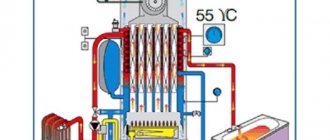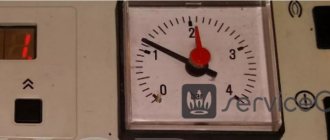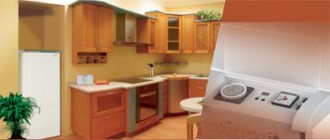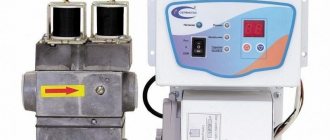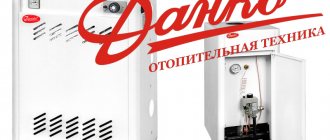what to do if the heating boiler boils
Boiler boiling
2. At some point, the nearby circuits stop heating, and all the batteries become cold, and the boiler boils.
The heating system is boiling. Why? Conclusion
3. Then I achieve the desired result in different ways: I feverishly twist the central plug in the pump, releasing steam and coolant, turn the pump on and off, the last time this all lasted more than 2 hours, the process is completely uncontrollable. It seems that the pump works on its own and does not pump anything, I do everything at random.
4. Then at some point suddenly everything seems to break through, the batteries ALL instantly become hot, and the temperature in the boiler drops to 60 degrees. Then everything can remain like this and work well for several hours, or again after 2-3 hours the batteries can cool down and the temperature in the boiler rises.
Heating scheme
Unfortunately, you did not indicate whether this is the first start after installation, or whether the heating system has worked successfully before. We will assume that the design and installation were carried out correctly, the capacity of the compensation tank and the cross-sections of the pipelines were chosen correctly. The floor wiring diagram that you sent is simple and should ensure satisfactory coolant circulation. By the way, connecting the radiator on the stairs to the vertical main is irrational; the correct solution would be to connect after the riser.
There may be several reasons why the coolant temperature periodically rises to a critical level, but the radiators remain cold:
Most often, such problems are caused by a “plug”, either air or mud. Air is released especially actively in the first month after filling the system; it is recommended to bleed it daily. An air ventilator (Maevsky tap) should be installed on each heating device. Automatic air vents are installed at the top points of heating lines, in the boiler room, on the boiler itself, on the collectors (judging by the diagram, you don’t have them). Airing of the system is the most common cause of unstable heating operation. We recommend starting the inspection by thoroughly bleeding the air, first at the top, moving down. If air has to be released frequently and the pressure in the system drops, the tightness has been broken somewhere.
The air ventilator should be installed on each heating radiator
A mud “plug” can also hinder the free flow of coolant. The first thing you should check is the filter, if there is one. Deaerators, especially needle type ones (Maevsky taps), can also clog dirt and sludge.
Such a device combines the functions of an automatic air deaerator and a dirt filter. Easy to maintain, allows you to ensure cleanliness and normal gas composition of the coolant
The reasons for unstable heating operation may also lie in your circulation pump. Although, more often it fails immediately and for good. You can check whether the pump is working by placing your hand on the body. A slight vibration should be felt. First, we recommend checking and cleaning the electrical contacts. The reason may lie in the wear of electric motor parts or in the formation of lime deposits if unprepared tap water is used as a coolant.
What are the ways to protect heating equipment from overheating?
In order to increase the consumer attractiveness of their products, manufacturing companies try to include any guarantees of their safety in the technical passport of boiler equipment. The uninitiated consumer has no idea about the means of protecting a heating boiler from boiling.
The following methods currently exist to ensure the protection of solid fuel units used for autonomous heating systems. The effectiveness of each method is explained by the operating conditions of boiler equipment and the design features of the units.
In most cases, in the technical data sheet for a heating device, manufacturers recommend using tap water for cooling. In some cases, solid fuel heating boilers are equipped with built-in additional heat exchangers. There are models of boilers with remote heat exchangers. A safety valve is used to prevent overheating. The safety valve is designed only to relieve excessive pressure in the system, while the safety valve allows access to tap water when the boiler overheats.
Important! In the presence of cast iron heating devices, such a measure is fundamentally incorrect. Cast iron heat exchangers are afraid of sudden temperature changes. Injecting cold water into the circuit may result in loss of integrity of the heat exchanger housing. (cast iron heated to a high temperature will simply burst upon contact with cold water).
Exceeding the temperature of the coolant above 100 0C creates excess pressure that opens the valve. Under the influence of tap water, which is supplied under pressure of 2-5 bar, hot water is forced out of the circuit by cold.
The first aspect that causes controversy about cooling with tap water is the lack of electricity to operate the pump. The expansion tank does not contain enough water to cool the boiler.
The second aspect that this cooling method rejects is related to the use of antifreeze as a coolant. If an emergency occurs, up to 150 liters of antifreeze will go into the sewer along with the incoming cold water. Is this method of protection worth it?
The presence of a UPS will allow you to maintain the operation of the circulating pump in a critical situation, with the help of which the coolant will evenly disperse through the pipeline without having time to overheat. As long as the battery capacity lasts, the uninterruptible power supply guarantees the operation of the pump. During this time, the boiler should not have time to heat up to critical parameters; the automation will work, running water through a spare, emergency circuit.
Another way to get out of a critical situation would be to install an emergency circuit in the piping of a solid fuel unit. Switching off the pump can be duplicated by the operation of a spare circuit with natural coolant circulation. The role of the emergency circuit is not to provide heating for residential premises, but only to be able to remove excess thermal energy in an emergency.
Note: the installation of an emergency circuit can be replaced by installing a bypass, which in extreme cases will divert overheated boiler water to an expansion tank or heat accumulator.
This scheme for organizing the protection of the heating unit from overheating is reliable, simple and easy to use. You will not need any special funds for its equipment and installation. The only conditions for such protection to work are:
- the presence of an expansion tank or storage tank in the system;
- use of a petal type check valve only;
- the secondary circuit pipes must be larger in diameter than the conventional heating circuit.
Why does a gas boiler boil?
During normal operation of the equipment, the coolant in the circuit warms up to the set temperature. After which it is distributed naturally or forcibly through the heating system through the pump. This is how the radiators in the room warm up. The liquid then moves along the return circuit and returns to the boiler.
In case of overheating of the coolant, thermal sensors are activated. As a result, the operation of the device is blocked. What to do if the boiler boils? To restore heating, it is necessary to find the cause of the breakdown. Sometimes the self-diagnosis system displays an error code:
- E01 for " ";
- E02 for ;
- A03 for " ";
- 01 for ;
- F20 for " ";
- 16 for etc.
But if this does not happen, the problem can be identified by external signs.
What causes overheating:
- Clogged filters;
- Air accumulation;
- The heat exchanger is clogged with scale;
- Problems with the circulation pump;
- Failure to comply with regulations for the premises where the equipment is installed.
How to restore boiler operation
If the equipment overheats, do not delay repairs. There are times when a gas boiler explodes, so fix the problem as soon as you notice it.
Blockage and airiness of the system
If water stagnates and does not circulate in the circuit, this leads to boiling. You can hear the liquid inside gurgling. Turn off the device and wait until the coolant cools down. Often the filters are valved on both sides so you don't have to drain all the water from the system. Turn on the taps, remove and wash the filters.
Filters that are worn out and cannot be cleaned should be replaced.
An air lock slows down the movement of the fluid or stops it altogether. How to deal with this:
Open the Mayevsky taps - they are on every radiator. Place containers under them first;
- You will hear air hissing out of the circuit. Then water can flow. Do not close the taps immediately. Wait until the liquid is drained and all the air is released;
- Repeat the procedure until the air lock is completely eliminated.
Scale deposits
Magnesium and potassium salts are deposited on boiler parts when heated above 55 degrees. Most of the scale deposits in the heat exchanger because the liquid circulates and heats up in it. As a result, the passages in the tubes narrow, the pressure decreases, and water boils in the assembly. This leads to overheating and damage to the heat exchanger.
At home, the radiator is placed in a metal container with warm water. A solution of citric acid is poured into the coil. The container is placed on the stove, where it warms up for half an hour.
To prevent scale formation, install magnetic filters. Their cassettes only need to be changed once a month, but they soften the water well.
Problems with the pump
When turning on the boiler after a long period of inactivity, you need to check the pump. Its parts could stick and the holes could become clogged. Clean and replace faulty parts.
Installation problems
When installing the boiler in a room with high humidity, the risk of corrosion increases. This leads to a violation of the tightness of the system, leakage of coolant and gas. Therefore, before choosing a place for equipment, read the requirements for it.
Be careful with gas equipment. Once a year, carry out breakdown prevention and technical inspection.
When the boiler is turned on, the water boils. what to do
Water in a heating boiler may boil because the rate of heating in the boiler exceeds the rate of heat transfer in the home heating system. This can happen for several reasons:
insufficient coolant circulation rate or its absence; insufficient amount of coolant (water) in the system - most often happens in open systems with an expansion tank; excess power of the heating boiler compared to the total power (heat transfer) of the heating radiators of the house, taking into account losses - in the absence of a system for regulating the draft (power) of the boiler; improper installation of the heating system.
If the coolant circulation rate is insufficient, the heated water does not have time to release the heat received in the boiler into the system and can heat up in the boiler to the boiling point. This can happen in heating systems with natural coolant circulation if the correct pipe installation slopes are not observed or, less often, if their diameter is insufficient. With a forced circulation system, this can happen if the circulation pump is not selected correctly, is faulty, does not work, or there is no electric current supplied to it.
Also, the water in the boiler may boil if for some reason there is not enough water in the system and air has entered it. If you have a heating system with natural circulation and a conventional expansion tank, this sometimes happens and in this case you just need to add water. Depending on the design of the heating system, sometimes it is necessary to bleed air from the system or some part of it (in the absence of an automatic valve).
To increase the circulation of water in the heating system, it is necessary to remodel the heating system or, best of all, install a circulation pump. Even with not entirely correct pipe slopes or in their absence, the circulation pump will provide the necessary circulation.
Water in the heating system can also boil if the installed boiler’s power is much higher than the heat transfer power of the entire system, especially if there is no or malfunction of the automatic regulation (draft) air supply system. In this case, it is necessary to install a semi- or automatic draft control system, replace the boiler (if it is homemade without a draft control system) or increase the number or power of radiators. Also, as an option, you can install an indirect water heater (boiler) in the system, which will take part of the heat from the system to heat water and serve as a kind of heat accumulator.
OBI sells a special liquid (like ANTIFREEZE for a car) specifically for heating systems in private homes—I recently saw it at OBI at Belaya Dacha
Good day. You urgently need to call heating system repair technicians. We had the same problem last year. We ourselves could not solve it, we called these masters https://toutletoutim.fr/
Why does water boil in a boiler or heating system?
Water in a heating boiler may boil because the rate of heating of the liquid in its heat exchanger exceeds the rate of heat transfer in the home heating system. In this case, the amount of thermal energy that the coolant (water) receives in the boiler per unit time exceeds the heat transfer capabilities of the system (pipes, radiators) and the temperature of the liquid at the inlet and outlet of the heat exchanger begins to rise. If this process is not regulated, then the water will boil sooner or later.
Thus, boiling of the coolant can occur for several reasons:
- excess power of the heating boiler compared to the total power (heat transfer) of the house heating radiators, taking into account losses - in the absence of a system for regulating its draft (power);
- insufficient coolant circulation rate or its absence;
- insufficient amount of coolant in the system - most often happens in open systems with an expansion tank;
- improper installation of the heating system.
Now let's look at these reasons in more detail.
A simple look at the problem.
The expansion tank plays an important role in the cooling system. Its main function is to dampen pressure fluctuations in pipelines that arise as a result of an increase (decrease) in the volume of antifreeze during heating (cooling). Thanks to the presence of such a container, mechanical loads on system elements are reduced, water hammer and the appearance of air locks are prevented.
In fact, the tank replenishes the lack of fluid in the lines during cooling and serves to receive excess fluid when heating. Structurally, it is made in the form of a plastic sealed container.
A mandatory part of the design is a safety valve for releasing excess pressure into the atmosphere.
When antifreeze heats up, it expands, filling the free space of the tank, and the evaporation rate increases. This leads to an increase in pressure in the volume. An increase in pressure above a threshold value triggers the built-in valve.
The only situation when antifreeze is thrown out of the expansion tank is when the valve fails to perform its assigned functions.
Principle of operation
Schematically, the OS heating circuit can be represented as a long vertical ring. One side of the ring
- with hot water (supply riser from the boiler to the boiler),
the other side
- with cold water (riser with return from the radiators). The density of a hot coolant is less than that of a cold fluid - water expands when heated.
Consequently, the weight of water and the pressure of the water column in the cold part of the circuit will be higher than the weight of water and the pressure of the column in the hot leg.
According to the law of communicating vessels, the liquid will tend to balance the pressures - to move from the cold branch to the hot one.
Since the circuit is such a closed ring, circulation or gravity flow of the coolant occurs.
- The supply riser is maximally insulated along its entire height.
- The boiler is located as far down as possible from the last radiator.
- The circuit has a container for releasing the excess volume of heated coolant
- an expansion tank (to ensure a reduced density and low pressure of the water column in the heated branch).
With natural circulation
During natural circulation, the coolant moves under the influence of the circulation pressure Pн
(in mm water column):
Pn=H x (cold - phot).
- H
- height difference between the boiler and the last radiator, m; - phol
- density of water in the cold return riser,
kg/m³
; - phot
- density of water in the hot supply riser,
kg/m³
.
During circulation along the circuit, the coolant spends part of the pressure to overcome the hydraulic resistance of pipes, radiators, and shut-off valves. Therefore, when designing an operating system, materials with low hydraulic resistance
so that their total does not exceed the design pressure
Pn
(do not block the system).
Important! The OS coolant contains air, which is mixed in the expansion tank. To remove air, pipes are made with a slope of at least 3-5 mm per p.
m. pipes.
With circulation from a pump
To increase the natural pressure, a circulation pump is included in the OS circuit.
There are two pump insertion points
to existing OS:
- On the return pipe in front of the boiler.
The expansion tank is reconnected to the return pipe in front of the pump (in the suction zone). - On the upper supply pipe
immediately after the expansion tank connection point.
Reference!
The pump insertion point is equipped
with a bypass
with a reed check valve.
Single-pipe
A single-pipe system with natural circulation is made only with upper coolant distribution.
All radiators in the riser of a single-pipe OS are connected in series - the output of one battery is connected to the input of another.
- Small number of pipes.
- Easy to install.
- The system is unbalanced
- the top batteries are hot, the bottom batteries are cold. To equalize the temperature regime, lower radiators are installed with a large number of sections. - Impossibility of thermoregulation
due to high resistance of control valves.
Expansion tank
Located in the attic. Since the attic is usually an unheated room, the tank must be insulated, otherwise the water in it may freeze in winter. The tank compensates for temperature fluctuations in the water level. In addition, sometimes water in the system can boil (this happens if you start heating the boiler too quickly), and the bubbles significantly increase the volume. This is what the excess volume in the expansion tank is for.
It is advisable to provide for the possibility of draining excess water from the tank when it overflows. To do this, water can be discharged either into the sewer or simply onto the street.
It should be borne in mind that water from an open system evaporates. Therefore, it is necessary to replenish the system with water. This can be done manually, periodically climbing into the attic and adding water, or you can make an expansion tank similar to a toilet - with automatic topping up of water.
But they rarely do this. Usually they just use a container.
It is better to close the top of the tank with a lid so that less water evaporates.
Expansion tank device
Structurally, this container is very simple. The material used is translucent plastic. Also, a sensor can be additionally built into the tank, which signals the driver about a critical decrease in the coolant level.
The top of the tank is closed with a lid in which a valve is installed to regulate the pressure. If the pressure in the system increases, then the valve operates.
Also on the wall of the tank there is a level indicator in the form of o and “maximum”, allowing you to control the liquid level
It is important to understand that on a cold engine the level should not fall below the minimum. It is also not allowed to exceed the maximum level
As for the tank cap with the valve, it seals the container hermetically on a cold internal combustion engine. However, when the engine reaches operating temperature and the coolant heats up, the pressure in the cooling system and in the tank naturally increases.
If the pressure rise reaches an average of 120 kPa, the valve opens. When the pressure drops to an average of about 83.4 kPa, the valve closes. This operation of the valve is necessary in order to avoid rupture of pipes, damage to the radiator, etc.
At the same time, after the engine cools down, the pressure in the system begins to drop, the volume of coolant decreases and a vacuum is created. When the pressure drops, on average, below 3 kPa, the inlet valve of the expansion tank opens to take in air. As a result, the pressure difference is leveled, and the missing volume of liquid is compensated from the tank.
How to repair boiler fault codes?
Boiler overheating error
Gas boiler malfunction in the form of overheating can occur due to lack of circulation. In this case, you need to check the pump and filter. The overheating thermostat may also be broken.
Low system pressure
If the pressure does not rise when the boiler warms up, then the tightness of the system may simply be broken and you need to tighten the connections, and then add a little pressure. If this problem arose almost immediately after installing the boiler, then you just need to remove the air through an automatic air vent and add a little water.
There is no draft of the gas boiler
If the boiler has an open combustion chamber, just check to see if it is clogged with anything. If the combustion chamber is closed, then condensate drips from the outer pipe, entering the inner one and freezing in the winter, turning into an icicle, blocking the access of air to the boiler. To eliminate this problem, you need to pour hot water over the resulting icicle. Another foreign object may also get into the chimney.
The boiler does not light a flame when ignited
This indicates a malfunction of the gas valve in the boiler. To verify this, you can unscrew the hose and see if gas is supplied. If there is gas, then you should call a specialist who will replace this valve.
The boiler lights up, but the flame goes out immediately
In this case, the panel may show a malfunction of the gas boiler in the form of a lack of ionization current. You need to check this by turning on the boiler again, turning the plug over, thereby changing the phases. If nothing has changed, then the operation of the ionization current may be disrupted due to some electrical work in the house. If the boiler periodically extinguishes the flame, then this is due to power surges and a stabilizer is needed.
The panel displays incorrect errors
Sometimes electronic board errors may occur. This happens due to poor electricity and poor quality power supply. This causes some parasitic charges to appear on the boards, which is why such errors are observed. To eliminate this, you need to disconnect the boiler from the network and let it stand for about 30 minutes. During this time, the capacitors will discharge and these unnecessary charges will disappear. After this, the boiler should work well.
In general, that's all. If the material was useful, do not forget to share it by clicking on the social media buttons below this text.
Also find out how to choose the right gas boiler so that there are no problems in the future:
Heating devices
In systems with natural circulation, you can use only radiators, as well as thick pipes as radiators (they have less hydraulic resistance).
But, alas, you cannot use convectors - natural circulation simply will not flow through them.
To summarize the above, an open system is a thing of the past. Slow heating, high inertia of the system, a large amount of soluble air, bulky pipes, and low efficiency make it unattractive for modern heating systems. So it is used in extreme cases - for example, in areas where electricity is often cut off.
The most popular now are closed systems with forced circulation of coolant, two-pipe or collector-beam.
Let's analyze the situation when water boils in a heating boiler, and it turns off in emergency mode due to overheating of the coolant. Let's look at several types of boilers and the common causes of this problem in them.
Reasons that may result in overheating of a solid fuel boiler
Even at the selection and purchase stage, it is important to take into account the performance characteristics of the heating device. Many models that are on sale today have a built-in overheating protection system. Whether it works or not is the second question. However, it is necessary to adhere to certain knowledge and skills in order to create an effective and safe autonomous heating system at home.
The reliable operation of the heating unit depends on the operating conditions. In case of obvious violations of the technological parameters of heating equipment and abuse of standard safety rules, there is a high probability of an emergency situation.
For reference: exceeding the temperature in the combustion chamber of the permissible parameters can cause boiler water to boil. The result of an uncontrolled process is depressurization of the heating circuit and destruction of the heat exchanger housing. In the case of hot water boilers, an explosion may occur if overheated.
Possible negative consequences can be prevented even at the stage of installation of a solid fuel boiler. Proper wiring of the heating apparatus will be the key to your safety and reliable operation of the unit in the future.
If we talk in detail, then in each case the protection system of a solid fuel boiler has its own specifics and features. Each heating system has its pros and cons. Eg:
- When it comes to solid fuel boilers with natural coolant circulation, it is necessary to take care of the safety and performance of the heating equipment even during installation. The pipes in the system are metal. Moreover, the diameter of such pipes must exceed the diameter of the pipes used to lay the circuit with forced circulation of the coolant. Sensors installed on the water circuit will indicate possible overheating of the coolant. The safety valve and expansion tank play the role of a compensator, reducing excess pressure in the system.
A significant disadvantage of a gravity heating system is the lack of an effective mechanism for adjusting the operating modes of solid fuel boilers.
- Great technological opportunities for consumers are provided by double-circuit solid fuel boilers that operate with forced circulation of coolant in the system. Just the presence of a second circuit significantly increases the ability to regulate the heating temperature of the boiler water. The only drawback in the operation of such a system is the running pump, which can cause difficulties during the operation of the heating system.
This is due to the fact that when the power is turned off, the pump stops performing its functions. Stopping the circulation process and inertia of solid fuel heating boilers can lead to overheating of the heating unit. If the boiler equipment is not equipped with an uninterruptible power supply, a power outage situation is fraught with extremely unpleasant consequences.
Effective protection against overheating of a working solid fuel boiler should be based on the mechanism for removing excess heat generated by the heating device.
An open heating system with natural circulation has a number of features
- There is a lot of dissolved air in the system, which can lead to corrosion of internal metal elements in the system.
- Great inertia of the system. After turning on the heating, the house heats up slowly. The system must be warmed up gradually, otherwise the water will simply boil in the boiler, while it will still be cold in the radiators.
- The house warms up evenly
- Large temperature difference between supply and return
- Fuel consumption is higher (low efficiency) than in a closed system with a circulation pump
- Independence from electricity
- The system is simple, there is practically nothing to break in it. Fairly simple installation.
- Aesthetically not very good, because... large diameter pipes are used, and sometimes pipes of increased diameter are used as radiators
- The system is quite cumbersome
- Antifreeze cannot be used in the system.
- The water from the system gradually evaporates, so it must be added periodically. It is advisable to install automatic topping up.
- The boiler must be installed at the lowest point of the system. The best place is in the basement, or in some kind of recess.
- The expansion tank is installed at the highest point of the system. If you install it in the attic, it must be insulated.
- Quiet operation due to the absence of a circulation pump
But nevertheless, this system has been successfully used and is used when installing heating in small private houses with a height of 1 or 2 floors.
Let us describe the entire system in order:
Not enough coolant in the system
Also, the water in the boiler can boil if for some reason there is not enough water (coolant) in the system and air gets into it. If you have a heating system with natural circulation and a conventional expansion tank, this sometimes happens and in this case you just need to add water. Depending on the design of the heating system, sometimes it is necessary to bleed air from the system or some part of it (in the absence of an automatic valve).
To increase the circulation of water in the heating system, it is necessary to remodel the heating system or, best of all, install a circulation pump. Even with not entirely correct pipe slopes or in their absence, the circulation pump will provide the necessary circulation.
Boilers with automatic ignition.
Water circulation in the heating circuit is disrupted.
Due to the slow movement of the coolant in the heating system, the water in the heat exchanger overheats and the boiler stops in emergency mode. The speed of fluid movement in the system can be affected by decreased performance or breakdown of the pump, contamination of the filter installed on the “return” of the heating circuit, or improper operation of the three-way valve.
The performance of the circulation pump is reduced due to contamination of the turbine blades or internal cavity.
Photo 1 – circulation pump module of a gas boiler with automatic ignition.
To revise it you need:
- Stop smoothly by moving the water temperature regulator knob to the extreme zero position and wait until the process is completed, turn off the power to the boiler.
- Remove the front part of the housing.
- Determine the installation location of the pump.
- Close the shut-off valve (No. 2, No. 3, No. 4 photo 2) of the supply, return, and cold water supply lines.
- Drain water from the boiler through the drain valve and leave it in the open position.
- Loosen the pump fasteners until air enters the circuit to drain residual fluid from the system.
- Remove the mount, power plug and remove the module (engine with turbine).
- Clean the blades, internal cavity and rubber seal of the mechanism from dirt.
- Assemble the pump.
- Open the cold water supply tap.
- Open the feed tap slightly to check the tightness of the hydraulic part of the boiler.
- Open the flow and return valve.
- Fill the system with water to a pressure of 1 bar.
- Turn on the boiler in circulation mode to remove air.
Photo 2 is an example of heating system pipe routing.
In boilers with electronic control, if the pump breaks down, the corresponding fault code will be displayed on the dashboard, which is deciphered using the boiler passport or electronic catalogs posted on the manufacturer’s website.
Checking and cleaning the filter:
- Smoothly stop the boiler.
- Using the taps (No. 1, No. 2) installed in front of and behind the filter, turn off the water supply.
- Using the filter drain valve, remove water from the isolated area.
- Unscrew the flask and clean the mesh catcher.
- Assemble all filter components.
- Open previously closed valves.
- If system pressure decreases, recharge the circuit.
- Turn the boiler to the venting position.
Checking the three-way valve.
In double-circuit wall-mounted gas boilers, switching from the heating mode to the hot water supply position is carried out using a three-way valve. It consists of a servo drive (motor with gearbox), rod, rubber seals, valve and body with inlets and outlets. A malfunction of this device can lead to a cessation of coolant circulation and, as a result, overheating of the heat exchanger occurs.
To check the condition of the three-way valve, it is necessary to smoothly stop the boiler and de-energize the system. Check the serviceability of the engine, and to do this, connect ohmmeter probes to the power terminals. If it shows 80 - 300 Ohms, then the engine is working, and if there are other readings (0 or 1), then it is faulty.
The three-way valve may not switch due to jamming of the drive gearbox, or due to deformation of the valve itself. If malfunctions of the valve are detected, it is replaced with a serviceable one or undergoes revision.
What to consider when repairing a boiler yourself
If there is smoke in the house or there is a clear smell of gas, first of all you need to turn off the boiler and open the doors and windows.
In some cases, you can deal with the breakdown yourself, without replacing parts. For example, if the combustion sensor fails, you need to completely turn off the boiler, disconnect it from the gas supply, let it cool, check for draft and restart. If there is no draft, then it is strictly forbidden to turn on the boiler and it is recommended to immediately call a technician.
The main reason for boiler overheating is contamination of the heat exchanger.
To eliminate this malfunction, it will be enough to clean the heat exchanger, which is the most effective measure. But sometimes the cause of overheating can be improper operation of the automation. In this case, you cannot do without calling a specialist.
If the fuel supply pipe becomes clogged, it is enough to disconnect the pipe from the system, clean and rinse it, dry it and reconnect it.
If the flame, which is constantly burning in standby mode, dies out, you need to find the instructions for the boiler and, following the recommendations, check the unit for clogging of the column.
To check the presence of draft in the chimney, be sure to make sure that there is no smell of gas in the room. Then hold a thin strip of newspaper near the chimney. If there is no traction, the newspaper will remain motionless.
Description of a device for remote control of a heating boiler, use cases.
In this article, we will not touch upon issues related to the choice of gas equipment. We will assume that this choice has already been made and we need to calculate the consumption of liquefied gas and its cost for a specific boiler.
3 comments
Thanks for the informative article! The boiler broke down, it’s good that it’s summer and I’m not freezing at home) Unfortunately, I don’t have time to do the repairs myself, so I want to contact zzz. According to reviews, the company is good, and thanks to your article I know what to check in their work, thank you!
Tell me, I notice a green flame in the burner of the gas boiler, is this normal?
Hello. The article is very useful. Could you help me? I have this problem. Water is not pumped when the make-up tap is open (heating boiler). The pressure does not rise or fall, while the pressure in the expansion tank is 1.2 bar. I tried to drain the water from the boiler with the supply to the boiler closed and the pumping open through the hot water tap. Doesn't merge. I bleed and pump air from the expansion tank - the pressure sensor changes readings, which means it’s working. I flushed the boiler with a booster, but it didn’t help. I suspect the pump valve is clogged. If so, how to remove it? I tried it, it didn’t work, I was afraid to break it. Maybe I should have pulled it harder? Please help me figure it out. I will be very glad for your answer. Thank you.
